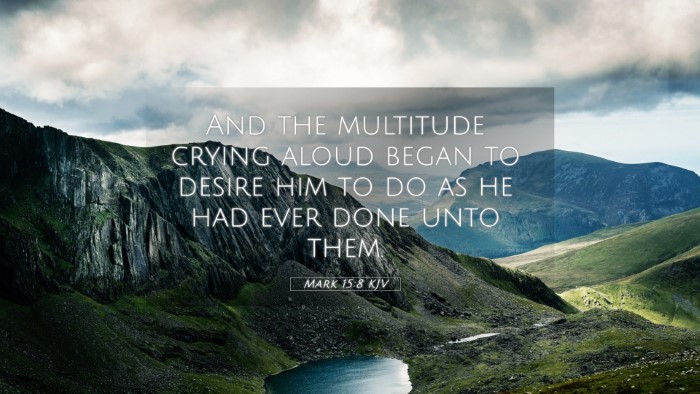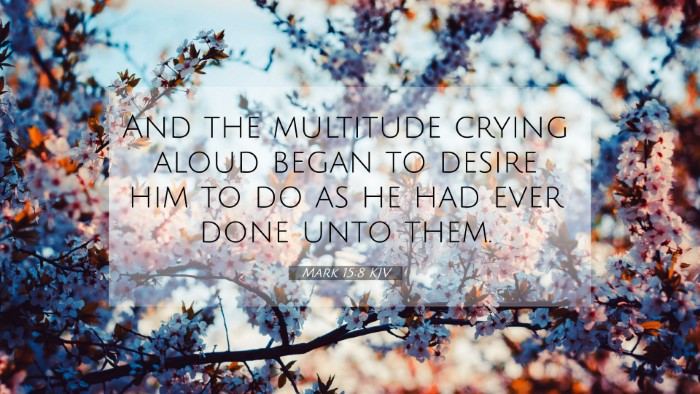Understanding Mark 15:8
Mark 15:8 reads: "And the multitude crying aloud began to desire him to do as he had ever done unto them." This pivotal moment in the Gospel of Mark invites deeper reflection and comparison with various biblical texts, revealing profound insights about the nature of humanity, public opinion, and divine purpose.
Contextual Analysis
In the context of Mark 15, Jesus stands before Pilate, where the Jewish leaders are pressing for his crucifixion. In this moment, the crowd calls for the release of Barabbas, a notorious prisoner, instead of Jesus. The essence of Mark 15:8 lies in the crowd's desires, which reflect the broader themes of choice, liberation, and the fickleness of public opinion.
Commentary Insights
Matthew Henry's Commentary
Matthew Henry points out the crowd's dynamic nature of preferring Barabbas to Jesus, illustrating how easily people's affections can be swayed. He emphasizes that this demand for Barabbas shows the depths of human depravity and the rejection of Christ, who offered them genuine salvation.
Albert Barnes' Notes
Albert Barnes expounds on the significance of the crowd’s request. He discusses the political motivations behind the demand for Barabbas, recognizing how the multitude’s cries reflect the desire for a deliverer who meets their temporal needs rather than their spiritual needs. This illustrates the duality of expectation from Jesus as the Messiah, contrasting societal desires with divine intent.
Adam Clarke's Commentary
Adam Clarke highlights the historical context, noting that the multitude’s decision was influenced by the chief priests who stirred up the crowd against Jesus. He connects this event to a broader theme of manipulation of public sentiment, warning of the perils of following the crowd without discernment.
Thematic Connections
- Human Choice and Divine Will: Mark 15:8 illustrates the autonomy of human choice in the face of divine will, resonating with passages such as John 6:70, where Jesus acknowledges Judas as a potential betrayer, reflecting human decisions amidst divine foreknowledge.
- Public Opinion and Its Influence: The theme of crowds and public opinion can be explored in Matthew 27:20, where the chief priests and elders persuade the crowd to ask for Barabbas. These connections emphasize the role of leadership in shaping communal desires.
- Contrast with True Freedom: The demand for Barabbas contrasts with the true freedom offered by Jesus as seen in Luke 4:18, where Jesus proclaims liberty to the captives. This thematic connection highlights the difference between physical and spiritual liberation.
- Fickleness of the Human Heart: The crowd's quick shift from welcoming Jesus (as in Matthew 21:9) to calling for his crucifixion illustrates humanity’s fickle nature, resonating with Proverbs 29:25 that teaches about the dangers of fearing man over God.
- Barabbas as a Symbol: Barabbas, which means "son of the father," can be seen as a twisted figure contrasting with Jesus, the true Son of God, akin to Romans 5:8 which speaks of Christ dying for the ungodly.
- Rejection of the Savior: The theme of rejection in Mark 15:8 parallels Matthew 21:42, where Jesus refers to himself as the rejected stone that becomes the cornerstone, emphasizing salvation's irony.
- Collective Responsibility for Sin: The crowd’s role in the crucifixion narrative echoes Isaiah 53:6, where it states, "All we like sheep have gone astray," recognizing the shared responsibility in the mainstream rejection of Christ.
Bible Cross-References for Mark 15:8
- Matthew 27:20 - The influence of the religious leaders over the crowd.
- John 18:40 - The crowd's choice between Jesus and a criminal.
- Matthew 21:9 - The earlier acclaim of Jesus by the crowds.
- Luke 4:18 - Jesus' mission to bring liberty, contrasting with the demand for Barabbas.
- Isaiah 53:6 - The collective nature of rejection and sin.
- Romans 5:8 - Christ's sacrificial love in contrast to human choice.
- Proverbs 29:25 - The perils of public opinion influencing action against divine truth.
Conclusions from Inter-Biblical Dialogue
Mark 15:8 serves not only as a historical account but as a litmus test for the reader's understanding of divine love versus human desire. The mingling of these insights sheds light on the complexities of faith, choice, and the nature of true salvation. Through comparative scripture analysis, notably how themes of rejection, freedom, and public sentiment are woven throughout the Bible, we are encouraged to seek a deeper understanding of God’s plan and our role within it.
Tools for Bible Cross-Referencing
For those engaging in deeper study, several tools are available for cross-referencing biblical texts:
- Bible Concordance: A useful resource for finding words and their occurrences.
- Cross-Reference Bible Study: Utilizing systems that link related passages.
- Bible Reference Resources: Books and online databases that provide extensive cross-references.
Final Thoughts
As we reflect on Mark 15:8 and its implications, it’s vital to be diligent in seeking connections between Bible verses that showcase the interwoven narrative of Scripture. This exploration through comparative Bible verse analysis provides valuable insights that not only enrich our understanding but also guide our journey in spiritual growth and faith.


